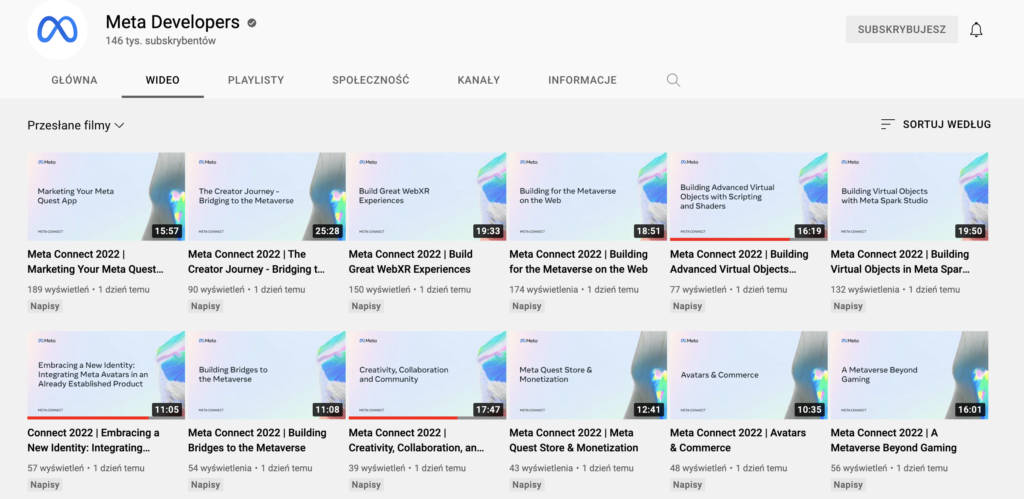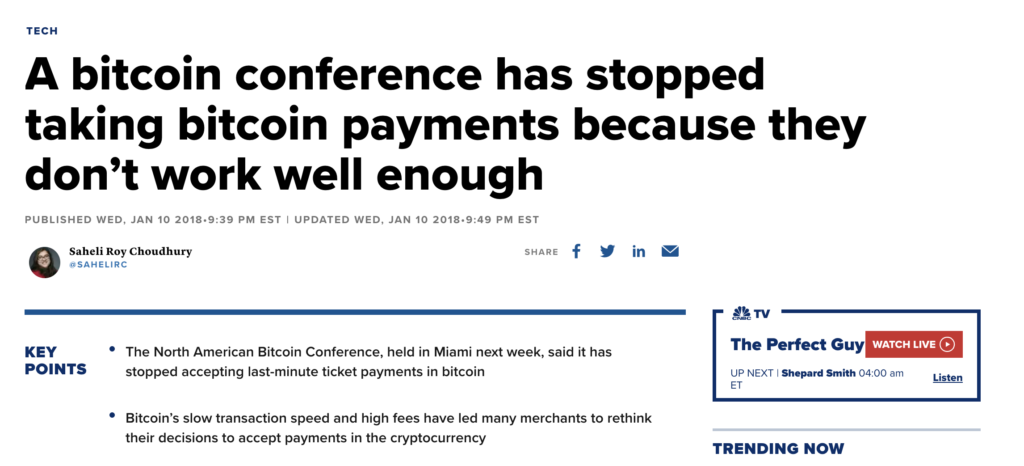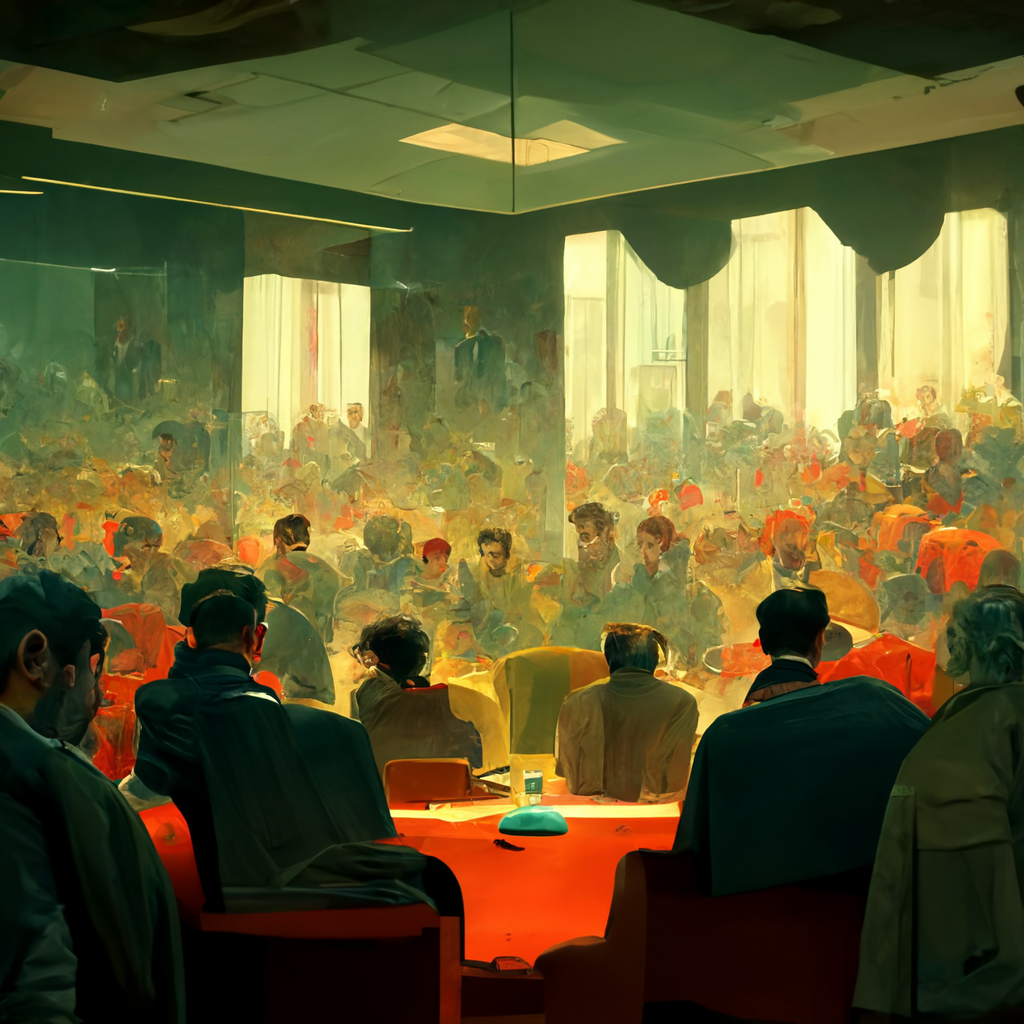Today’s edition will focus mainly on announcements from the Meta Connect, Microsoft Ignite, and Google Cloud Next conferences. With so many big players deciding to compete for attention, we came out with such an excellent themed summary.
Sorry for the lack of summary a week ago, illness laid me out 😒
And now to the point!
1. What we have left of the Metaverse one year after Mark Zuckeberg’s announcement
We are in the middle of October, the days are getting shorter, the leaves are falling from the trees, and Halloween is fast approaching us. Considering all this, I think it’s high time to talk about the living dead. And I guess Metaversum’s vision can be considered one, given the “hype” surrounding the Decentraland project over the past week.
From the beginning, Decentraland was created as a major player in the Metaverse market, a successor to Second Life. That’s why the analysis saying that this project, which has more than $1 billion in market value, uses… 36 users circulated widely on the web. Of course, as the information hit the headlines, the company quickly decided to debunk it, claiming that the results presented were unreliable. Indeed, the company’s internal calculations indicate 8,000 daily active users. Well, a number already a little better still shows how niche the whole Metaversum project is, considering the results achieved by one of the most significant projects. In the post, you’ll find a little more detail exploring the market size, such as the number of accessories and emoticons sold.

The truth is, however, that we all laugh a little at Decentraland here (especially at the misguided translations). Still, pioneering projects always have it tough, whether you’re a small startup or a big BigTech. After all, we are slowly approaching the anniversary of Facebook’s famous rebranding to Meta in late October last year. I remember it very well, mainly because I wrote probably my best edition of this summary by now and because Covid caught up with me at the time (which may explain the sudden surge of inspiration). A year later, it would seem that Mark Zuckerberg’s grand vision of a new direction for the company was a mistake. Since the conference in question, Facebook’s value has been plummeting sharply (60% year-on-year and doesn’t seem to be holding back), and the press has been flooded with reports that even Facebook employees don’t want to use Horizon.
Everyone laughs at Meta, and everyone gives a damn about it, which is why this year’s edition of Connect, the annual Facebook event, went completely unnoticed. The only thing that broke through into the more mass consciousness was the announcement of a partnership with Microsoft (we’ll come back to the Redmond-based company in a moment, by the way), which accompanied the launch of the new Quest – Meta’s flagship VR helmet, this time much more powerful than its predecessors (and unfortunately also much less pleasantly priced). And with all my heart for all sorts of Moonshots, I probably wouldn’t have even bothered informing you about the whole thing if it weren’t for YouTube. This one reminded me that I subscribe to Facebook’s developer channels, alleging nearly thirty sessions from the conference itself. So I started browsing through them, and let me tell you… it’s even enjoyable.
Indeed, the individual sessions touch on specific engineering details, like spatial audio, hand tracking, and leg tracking, which have been the arch-enemy of Facebook avatars from the beginning. It reminds me that all those Mii-like avatars from Horizon are just an intermediate step. I don’t know if anyone needs Metaverse (and I doubt it more and more every month). Still, it’s undoubtedly an umbrella that allows for the development of many fields, from hard-engineered VR glasses to Facebook’s widely promoted Presence Platform to immersive UX and Mixed Reality. And while we are in the early stages, the whole thing is undoubtedly moving technology forward. And there is something exciting about it.

Sources
- It’s Lonely in the Metaverse: DappRadar Data Suggests Decentraland Has 38 ‘Daily Active’ Users in $1.3B Ecosystem
- How Many DAU Does Decentraland Have?
- Meta’s Horizon Worlds quality is so poor, not even employees are using it, says VP in leaked memo
- youtube.com/c/MetaDevelopers

2. What Microsoft showed at Ignite 2022?
It wasn’t just Facebook’s conference that went unnoticed. The annual Microsoft Ignite also took place this week, and it, too, did not pass with much fanfare. However, this does not mean that there was nothing interesting at it, so I will step into the shoes of your guide to the as usual huge “book of news” that accompanies every Microsoft event.
The truth is that most of the most exciting announcements were about AI. Indeed, users of the Azure OpenAI Service have been given access to Dall-E 2, which would probably have received more hype if it weren’t for the fact that the model has only recently been available for public access. Its Microsoft distribution that makes integrating it with third-party applications easier, allowing it to go beyond being an enthusiast toy. From my perspective, the possibilities offered by Azure Cognitive Services for Language – it is supposed to provide efficient document summarization – sound interesting as well. Unfortunately, the whole thing is currently in closed beta, as is the accompanying Azure Cognitive Service for Speech, which works similarly to the Whisper from OpenAI I recently presented. It would be interesting to see if Microsoft takes advantage of its close partner here.
If you use Azure, on the other hand, a particular advance (albeit also incremental rather than a great revolution) has occurred in the context of databases. From my perspective, the most interesting novelty is the provision of CosmosDB compatibility with distributed PostgresDB, so we can forget about something like scaling the database (for that, we start worrying about CosmosDB credit consumption calculations, so it’s a bit of one-upmanship). Kubernetes users, meanwhile, got (in preview for now) Kubernetes Fleet Manager, which is the de-facto next abstraction over Azure Kubernetes Service, making it easier to work on REALLY large clusters. Also, Azure Deployment Environments are finally going into testing, making it easy to create templates for entire deployment environments, and Microsoft Dev Box – Microsoft’s attempt to bite the increasingly popular Cloud Workstation market. Both projects were announced back at Microsoft Build, so it’s good to finally have them in our hands. It’s clear, however, that the mid-year conference is the “big” one, and Ignite is such a little brother to it.

Oh, and one more thing – at the conference we had to say goodbye to the Office. This one finally went through another step of its rebranding – first from Office to Office 365, so that now the entire toolkit is renamed Microsoft 365, which pins together all the tools that enable business productivity, that is, in addition to Word, Excel also Teams, for example. The latter program has received perhaps the most news overall, so if you use it, you may want to take a peek here. Privately, by the way, I still think that of all the big players it is Microsoft that has the best remote collaboration tools.

Sources

3. And what did Google Cloud Next bring?
The last major conference, meanwhile, was Google Cloud Next. As with ignite, this is an event of a slightly different caliber than, say, Google I/O, and aimed at a very specific audience – users of Google’s Cloud. Once again, however, several announcements came out at it, with a chance to break through to a slightly wider awareness.
Google announced a lot of partnerships during its event. In the mass consciousness, the Mountain View company’s cloud has always been the weakest player, which may do quite well in AI, but that’s where its advantages end. However, with these reports, Google decided to show off a slew of new regions, customers, and partners. The company boasted that new GCP regions will appear in Austria, the Czech Republic, Greece, Norway, South Africa and Sweden. We also learned that GCP is being used by T-Mobile, Toyota or Accenture. Nice. Yet it’s also not as if there’s some excellent choice on the shelves of cloud computing stores today and you can pick and choose.
However, the news that perhaps resonated most widely was the announcement of a partnership with Coinbase. And not just because Coinbase uses Google’s servers the exchange has become the official payment provider for the cloud giant. In practice, this means that GCP is the first cloud that can be paid using the most significant cryptocurrencies, even DOGE. I’ll admit that I’d love to see sometimes from now the statistics saying how many customers have opted for this.

Well, okay, but Google Cloud Next also showed some technological developments. The conference again showed how important for Google is BigQuery – as this one got a preview of integration with Apache Spark and standardized data replication from popular relational databases. BigQuery has also received support for unstructured data, which is expected to facilitate its use in Machine Learning projects.
And in the context of security, Chronicle Security Operations – a software suite that better enables cybersecurity teams to detect, investigate and respond to threats – was unveiled. The solution aggregates data from multiple sources, including VirusTotal and Google Cloud Threat Intelligence, in one place so that when things go wrong, decision-makers don’t have to operate in the dark and can quickly explore the entire context of a security incident. The company also showe Software Delivery Shield, intended as a response to so-called Software Supply Chain attacks. It will provide holistic monitoring of every element of the development process – from on-premises environments to CI/CD to deployment.

Finishing up a bit, from the point of view of a programmer who has had to deal with Legacy systems in his life, I’m very interested in the probably relatively niche functionality – being able to easily move mainframe environments to the cloud using the so-called Dual Run, which is the result of a collaboration between Google and VMWare. I’d like to try such a migration again someday to see how Google solution works in practice.
And of course, as it happens with the big players, just as Microsoft showed off Dev Box and changes to Teams, so with Google, we also have news in Workspaces and the announcement of Cloud Workstation – a service allowing to offload developers’ machines.

Sources
- Google Cloud to Let Users Pay With Bitcoin, Ethereum, Dogecoin via Coinbase
- Introducing Chronicle Security Operations: Detect, investigate, and respond to cyberthreats with the speed, scale, and intelligence of Google
- Key partnerships announced at Google Cloud Next 2022
- Google Cloud announces Dual Run to ease mainframe migration to cloud
- Google announces updates for BigQuery data warehouse




